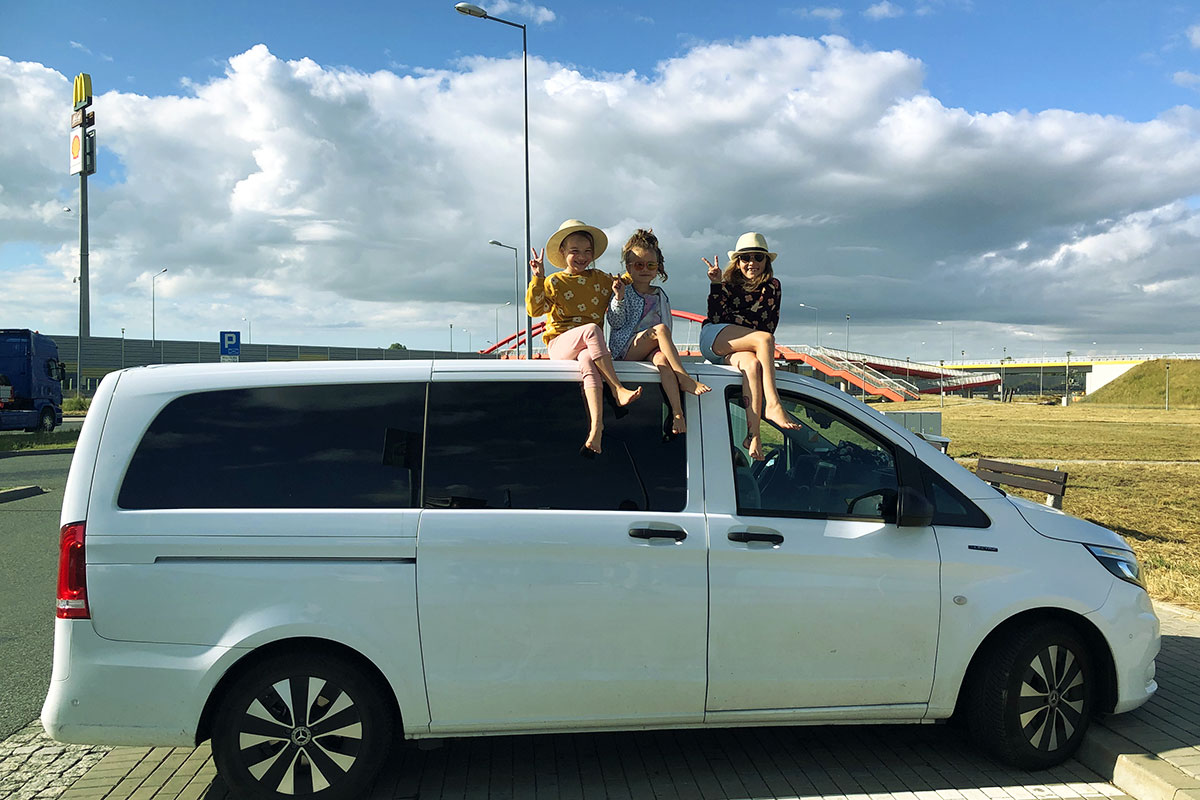Touring Italy with four children and an electric bus. Why not!

The little ladies knew how to enjoy the trip
Margus Ots is a busy father of four children, acting in the field of IT on a daily basis. This summer, he and his family took a road trip from Estonia to Italy and back. By electric bus. Let's find out how this crazy idea became a reality.
First of all, Margus, I can't help but ask. What made you decide in favour of an electric vehicle?
Driving comfort and economy are the keywords. City trips are about 2.5 times cheaper than with my previous car. I have to admit it was physically painful to fill up, looking at petrol prices.
I drive a Mercedes-Benz eVito Tourer, and my kids like that the car is quiet. You can hear birds singing and crickets chirping.
The maintenance costs of an electric vehicle are minimal. The only things that wear out are the brake discs. Most of the time I brake with the engine while charging the battery.
Looking back, was it a crazy idea to pack up the family and go on an electric bus tour of Italy?
At first it did seem crazy. We had never travelled so long as a family before, and we had only had an electric car for a short while.
In addition to my partner, we had girls aged 9, 7 and 5 as well as a 1-year-old boy travelling with us. On the way there, we had a quick three-day trip, then spent a week at a children's music camp, and returned at a more peaceful pace - in six days. We covered about 3,100 km in total.
How much planning does travelling by EV require? How and according to what did you plan your route and car charging?
We planned the route and charging according to the locations of fast chargers, we used the Plugshare app. We mostly charged the car's battery to 80-90%, and started looking for a new charging point at about 20%.
We had to charge more often when driving through wilder places or heading uphill. When going up to the Alps, our electricity consumption almost tripled.
Did you calculate how much money you saved on fuel?
Our overloaded bus consumed electricity for 420 euros. We charged in fast chargers and did not filter locations by price. Better preliminary work could certainly have saved more.
It would definitely have cost a few hundred euros more with a regular fuel bus.
Many people are afraid to take such long trips with an electric car. Are these fears justified?
Yes and no, there are some nuances: either to get there quickly or to enjoy the ride.
When driving at 120-130 km/h on highways, the air resistance of our eVito became too high, and as a result, the battery consumed much more. So, we took it slowly along smaller roads. We lost time, but we saved on customs and saw more.
Of course, you have to take your time when travelling. Charging stops are longer, but allow you to do some stretching at the same time.
What is the state of the rest of Europe's electric car charging network compared to Estonia? Is there something for us to learn, or is there something for others to adopt from us instead?
The most annoying thing was to download the app, enter information, etc. at each new charger. Only then did it become clear whether the charger was functional at all. Often the information was in the language of the respective country, and customer support only knew how to restart - it helped in one case out of four. For some reason, there were more charging failures in larger cities with more load.
It would be ideal if it were possible to pay for charging through card payment, or simply by waving and without registration. I would be willing to pay a higher price for such convenience. It would also be great to have clear information if the charger is not working.
Lithuania makes a good gesture for electric car drivers: there are chargers along the highways where you can charge for 30 minutes for free. Many locals were supposed to use this option, but surprisingly, there were mostly no queues.
Were there times when you thought it would have been easier with an internal combustion engine?
It happened twice. In Poland, I spent an hour trying to download an app. When I finally realized to google and put Poland as the location country on my phone, the problems disappeared.
Also when I tried the highways. My bus was stable and moved quickly, but the economy suffered badly.
A little bit about another topic. You live in an apartment building where installing a personal charger may not be the easiest. Do you have any user-based suggestions on how to solve these bottlenecks?
We charge with a home charger directly from our electrical panel - it takes longer, but luckily we have a public fast charger nearby. If a private person wants a fast charger for their apartment building, it can cost the price of a car in some cases.
I would favour installing a larger number of fast chargers near supermarkets, gyms and other accessible places, and providing a discount there. In general, there are so few electric cars or they are so scattered that it may not pay off to install them with the same density near homes.
Is there anything else we haven't asked that you'd like to add?
An electric car requires a change in mindset. Speed is no longer important, but economy. We will never switch back to a petrol car.
An interesting surprise was the descent from the Alps. We planned 1-2 charging stops for that journey, but ended up driving more than 400 kilometres to the hotel without charging. When driving down the hill, the battery had fully charged itself.


